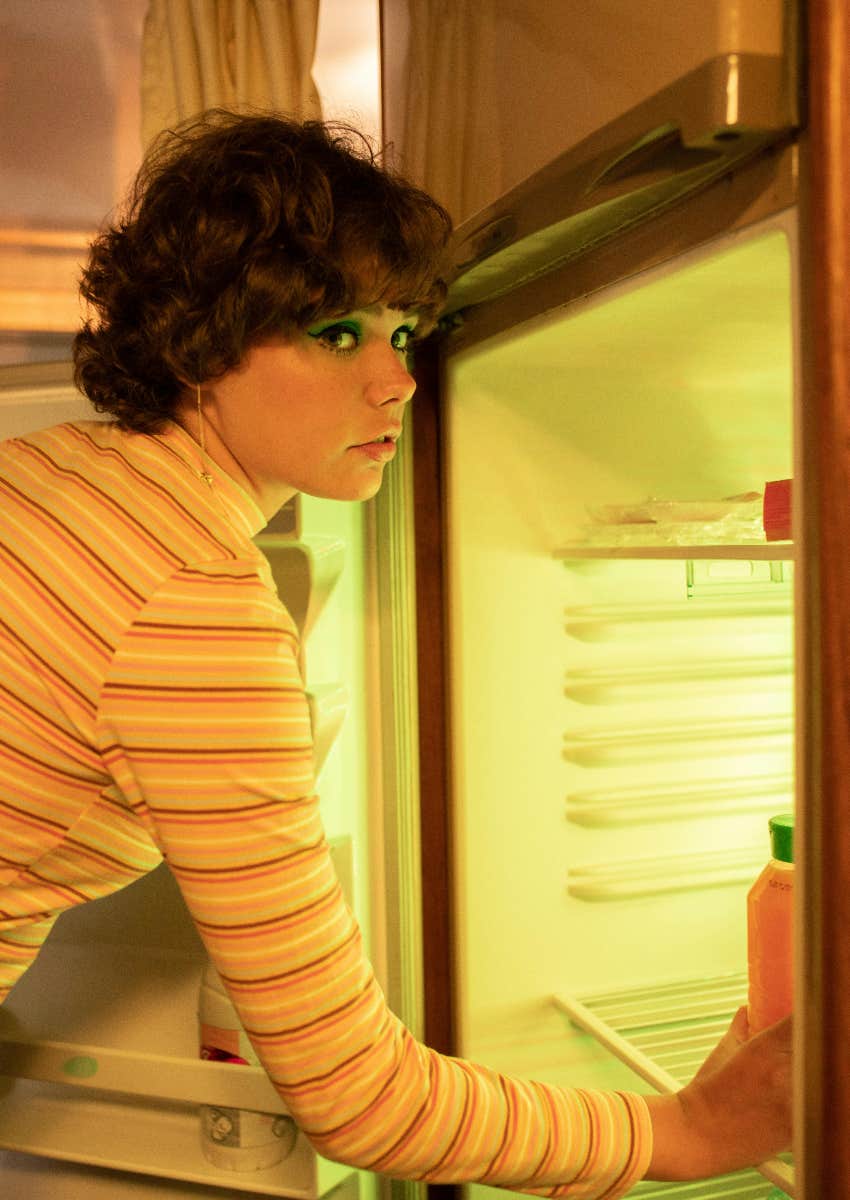My Childhood Trauma Created Disordered Eating Habits — 'I Was Constantly Hungry As A Kid'
How I healed myself from a mother wound that caused toxic eating habits.
 simonapilollatnf | Canva
simonapilollatnf | Canva People often discuss daddy issues when describing a woman’s dating behavior, but there isn’t much talk about the mother wound. Simply put, the mother wound speaks to a loss or lack of mothering, and the term typically refers to the mother-daughter relationship.
The wound, or pain, is often generational, meaning it’s passed down from generation to generation, and many connect the mother wound to a patriarchal society where women are considered "less than."
School was starting in a few days, and I was surprised when my mother asked if I wanted to celebrate by going out for an ice cream sundae. Her kindness puzzled me.
The idea that my aloof mother wanted to dote on me was a novelty that brought butterflies to my stomach. When we were situated in the booth at the diner, she let me tell the waitress what I wanted, which was also an uncommon treat. A hot fudge sundae with extra whipping cream was my choice. I didn’t love the cherry that came on top, but it looked pretty.
When my special treat arrived, my mother excused herself to go into the adjoining bar to meet a male friend, leaving me to sit alone. I should have known this trip to the diner was too good to be true.
The only thing that made this particular memory unique was that a hot fudge sundae accompanied my disappointment. My shame started early.
As a little girl, I often felt discarded and abandoned. The deep sense of shame I grew up with accompanied me into adulthood, which made relationships challenging.
I could never be sure that people didn’t have an ulterior motive, even when they were being kind. Along with my shame, I also felt I lacked value. Month after month, throughout my childhood, this perception was reinforced over and over until it was etched into me like a permanent tattoo.
My mother’s lack of concern over whether I was eating and my constant hunger led to disordered eating later in my life. After my mother died, I started to question why I needed to eat before bed every night and why I indulged in food to a degree that wasn’t normal or healthy.
One night, a few months after my mom’s death, I opened the refrigerator and realized I wasn’t hungry. But like an addict needing a fix, I couldn’t shut the door. As I crawled into bed, I begged the universe for clarity and got it. I can’t explain how I received the answer, but it unfolded in my mind without restraint.
 Athena Sandrini / Pexels
Athena Sandrini / Pexels
I saw that my compulsion stemmed from being repeatedly hungry as a child. In adulthood, I mitigated my internalized fear of being deprived of food by always eating before bed.
I have utilized mindfulness practices to combat my fear-based food trauma and have created new food-related habits. Mindfulness can help bring you back to the present moment, according to research from 2013.
Sometimes, I skip eating something I want, like a pastry (or two!) from my favorite local French bakery. This denial reaffirms I’m in control of what I eat rather than binging on something I love just because I can.
For me, it’s all about balance now. I had an unusual amount of unsettling fear and discomfort when I began working on my food issues. But I have made progress through mindful repetition and am much more at peace.
There are many ways my mother shirked her parenting duties. She regularly failed to ensure I was up and ready for elementary school before she left for work, didn’t provide me with tools for basic hygiene, and left me alone at home to go on dates with a string of men. But I’m finding that what’s essential for me to focus on now is that I’m healing, growing, and working to be the best version of myself despite my mother wound.
It isn’t easy to separate what happened to me as a child from who I am. It often feels like my childhood trauma saturated every cell of my being, making it a challenge to find my true identity as an adult.
My mother wound issues were compounded by the fact that I was also hiding my sexuality. I’ve known since childhood that I was attracted to the same sex, but I never felt safe enough to come out. So, I tried to live my life as though I were straight.
Because of my mother’s neglect and my father’s alcoholism, I learned to disassociate from what was happening around me. I compartmentalized my feelings and experiences and disengaged emotionally. This served me well when I married a man at twenty-five.
This coping mechanism also meant that I couldn’t engage in relationships meaningfully. I could play the part, but I was emotionally aloof, and because there was never a guarantee that I would be loved, I always held my true self back.
I was plagued by the idea that I had to earn love by being the ideal friend, model wife, or perfect mother. That type of mindset is exhausting, and it took me until I was fifty to break free.
Depleted and depressed, I began searching for authenticity in my 40s. I had no idea who I was or how to discover her. Therapy provided the perfect environment to expose who I was and what I wanted out of my life.
 SHVETS production / Pexels
SHVETS production / Pexels
One of the things I identified in therapy was that I had a victim mindset that completely denatured my power.
Blaming those who wounded me was a great way to abandon my responsibility for my actions, choices, and growth. Seeing that reality was stunning.
The other thing that helped me considerably was realizing that I held the pen that would write the rest of my story. For far too long, I allowed others to hold the pen, acting as though I was glad just to be included in the story they were writing for me.
This new, powerful realization allowed me to finally come out of the closet at fifty and start writing my own story the way I had always wished it to be written. Since then, amazing things happened in my life.
I received an unexpected job promotion that gave me a leadership position tailor-made for my strengths and abilities. I experienced a drastic improvement in my mental and physical health, allowing me to enjoy life more. Lastly, I fell in love and developed a relationship with a woman who surpassed every fantasy I’d had about experiencing same-sex love.
It would seem that once I ditched my victim mentality and embraced my true identity, I unlocked the power to manifest my unavowed dreams and desires. Living our truth is powerful and dynamic. Having a victim mentality, according to research from 2021, can make forgiveness and your life harder.
Authenticity isn’t a free pass to a happy and fulfilled life void of problems. It is a gateway to the freedom and peace that comes from knowing and embracing who you are. And that, my friends, is worth celebrating with a hot fudge sundae with extra whipping cream.
Children need enough care to be healthy and enough supervision to be safe.
Child neglect is when a parent or caregiver does not give the care, supervision, affection, and support needed for a child’s health, safety, and well-being. Adults who care for children must provide clothing, food, and drink. A child also needs safe, healthy shelter, and adequate supervision. There are several kinds of child neglect, which you can read more about on the Childhelp National Child Abuse Hotline’s website.
There is no “smoking gun” for most child neglect. While even one instance of neglect can cause lifelong harm to a child, neglect often requires a pattern of behavior over some time. If you suspect a child you know is being neglected, contact the Childhelp National Child Abuse Hotline for more resources at 1-800-4-A-CHILD.
Kim Kelly (she/her) is a writer and speaker who writes about authenticity, retirement, relationships, and life on the road.

